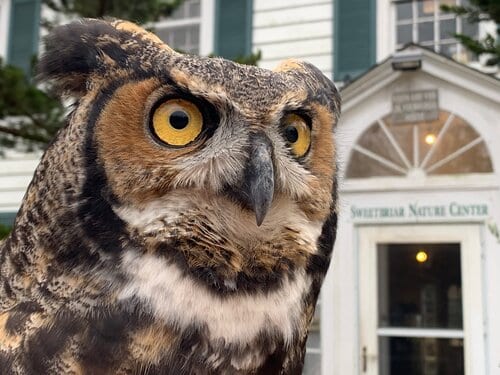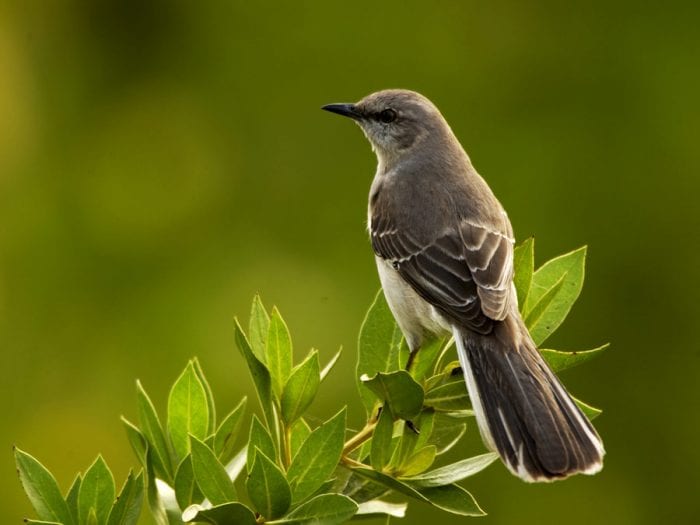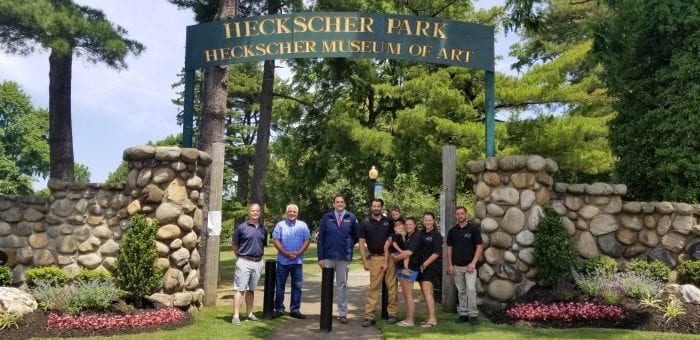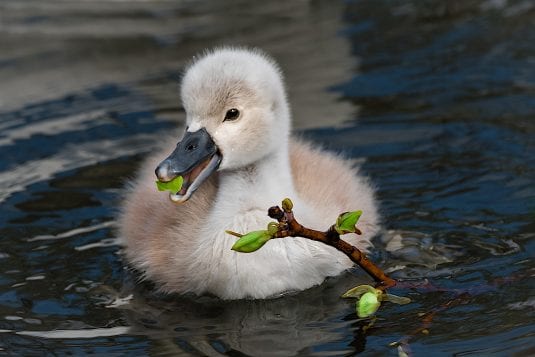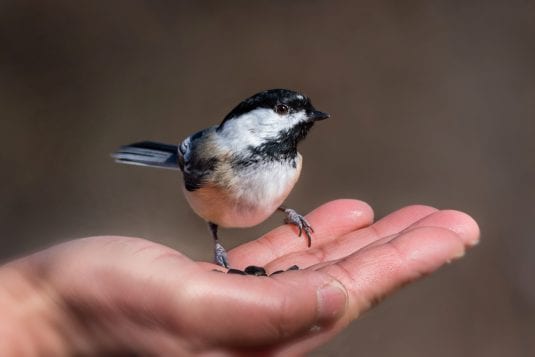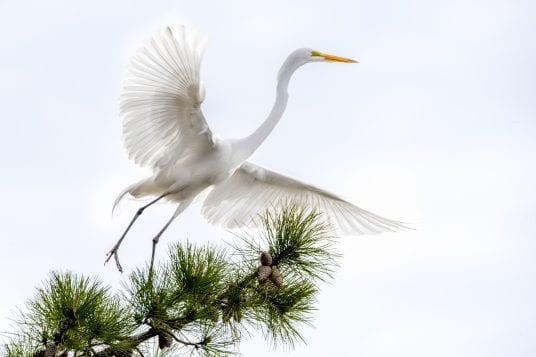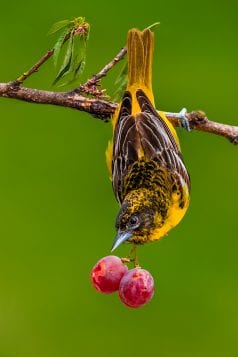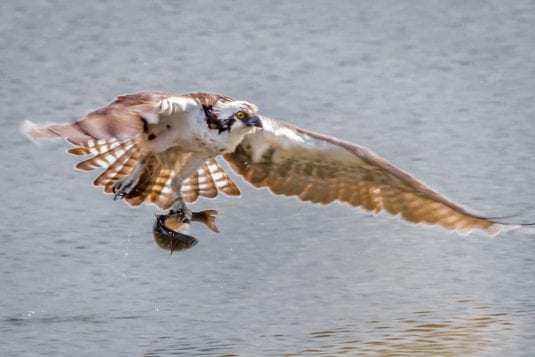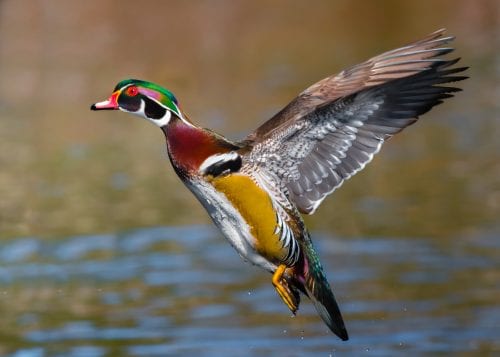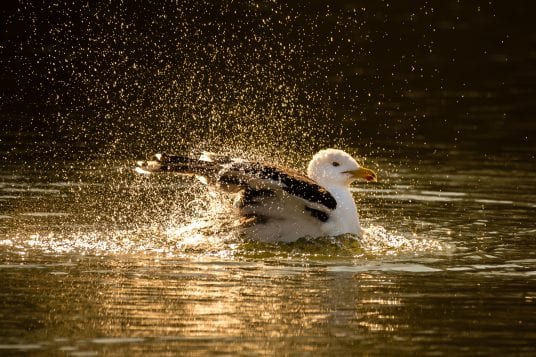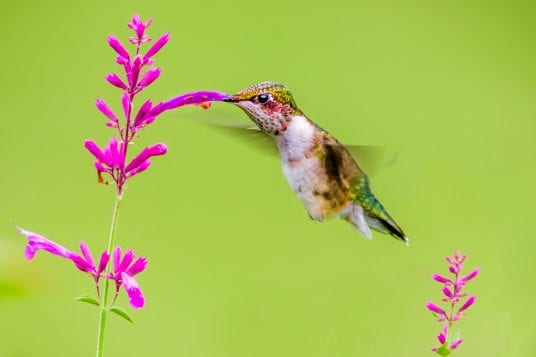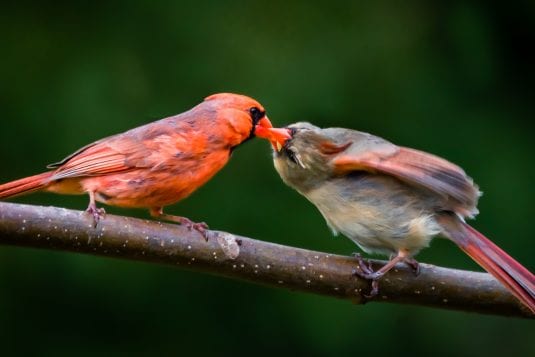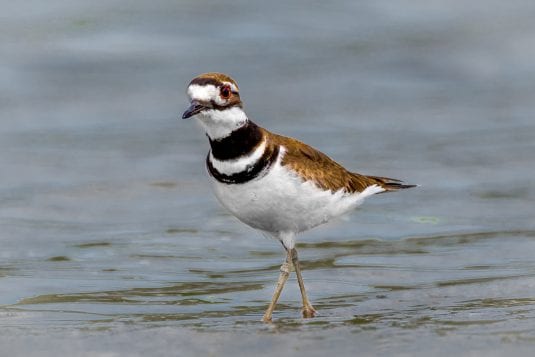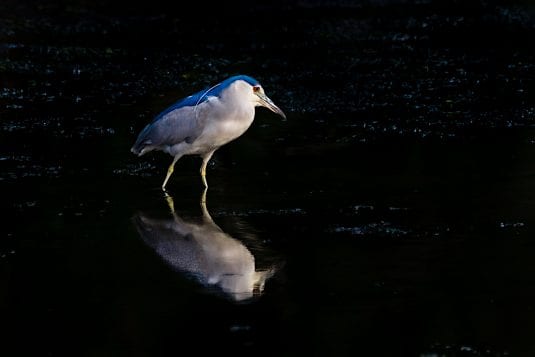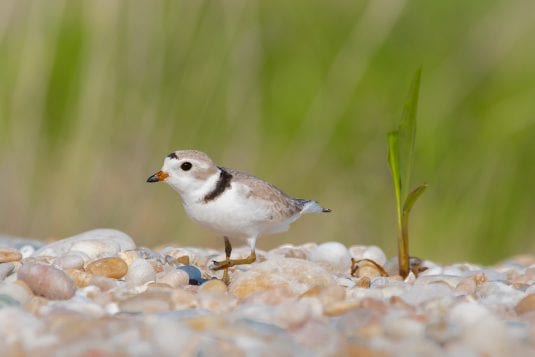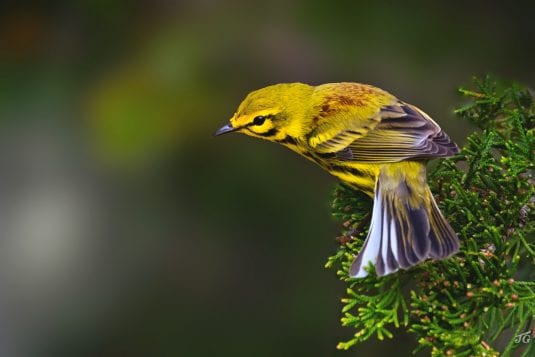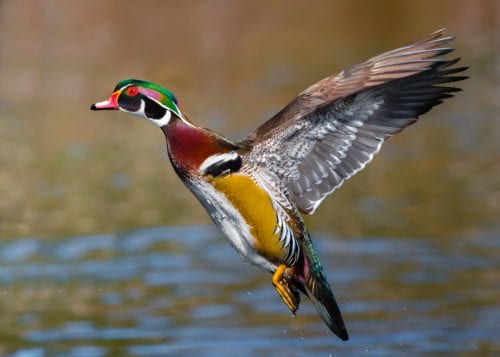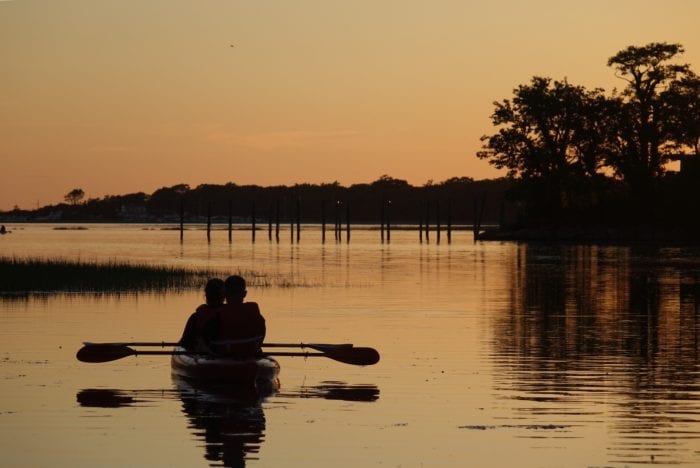Visit Sweetbriar Nature Center, 62 Eckernkamp Drive, Smithtown for a special Creatures of the Night fundraiser program on Friday, July 17 from 7 to 8 p.m. Meet some nocturnal animals and embark on a walk into the darkness to enjoy the night and maybe call in an owl or two. Bug spray is highly recommended, bring a flashlight, and bring a mask for when you can’t physically distance more than 6 feet. The hike will be self guided and the trails will be lit with lanterns. Adults and teens only. Cost is $10 per person. To purchase tickets, visit www.sweetbriarnc.org. For more information, call 631-979-6344.
Tropical Storm Fay Heads Towards Long Island
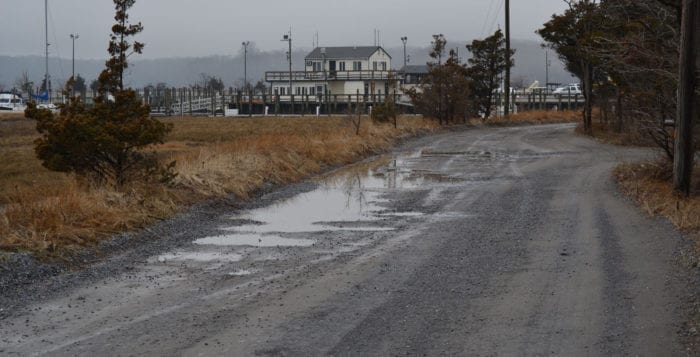
With Tropical Storm Fay heading towards Long Island, County Executive Steve Bellone (D) said Long Island was expecting rainfall through 3 a.m.
Bellone urged residents to “stay alert” and “secure any loose objects to prevent damage.” He also suggested that people avoid travel and not to attempt to drive over a flooded road.
Residents who want to report outages can text OUT to 773454 (or PSEGLI). Those who can get online can report the outage to PSEGLINY.com or call (800) 490-0075.
The viral numbers continued to remain within the range of their recent low-infection pattern.
Among 6,245 residents who received tests, 62 of them tested positive, for a rate of 1 percent. That brings the total for the county who have tested positive since the beginning of the pandemic to 41,711.
The county had 20,301 residents who tested positive for the antibody but who hadn’t had a prior test for the virus.
Hospitalizations rose by two to 54, while the number of people in Intensive Care Unit beds declined by 1 to 10.
Hospital bed occupancy was at 70 percent overall and at 60 percent for ICU beds.
One person died in the last day, increasing the total of losses for families, neighbors and communities to 1,992.
A dozen people were discharged from the hospital in the last day.
Next week, residents can pre-register for antibody tests at three locations. They need to call (833) 433-7369.
Bellone urged the legislature to allow voters to consider two ballot measures that would allow the county to use up to $50 million of funds to plug the budgetary shortfall created by the economic collapse triggered by the lockdown.
“To address this fiscal crisis, we should do everything we possibly can to avoid two things: laying off essential workers and adding significant new tax burdens on our homeowners during the worst economic downturn since the Great Depression,” Bellone said on a conference call with reporters.
While some environmental groups have opposed the moves, Bellone said neither measure would “take a dime away from existing environmental programs” and suggested that they were “common sense measures” designed to avoid increasing taxes or laying off essential employees.
The county has to create a budget, which Bellone hopes includes financial help at the federal level, to close a gap that could be as high as $839 million by September.
Nature Matters: The ‘many throated mimic’
By John L. Turner
A fact about living in suburbia is the presence of neighbors and we are blessed in having a bunch of wonderful neighbors in the Setauket neighborhood in which we live.
Lately though, I have become aware of, and begun to appreciate, another set of neighbors: those of the feathered kind. We are neighbors to the birds and this spring I’ve watched families of birds, going about their lives, amidst our property and that of some of our neighbors. Our human properties are embedded within the “properties” in which they nest.
In a side shrub a pair of Song Sparrows made a nest while in a front yard shrub it was a Robin. On an eye-level branch of a Norway Spruce located along a boundary of the backyard I watched a pair of Mourning Doves raise a pair of young that successfully fledged, and further back in a blackberry bramble was a Catbird nest.
We also routinely see several woodpeckers species feeding in the yard and have Carolina Wrens, Northern Cardinals, Black-capped Chickadees, for whom our property is a cafeteria. Most recently, we’ve been witness to a family of Screech Owls — two parents and three young — as they have begun, on silent wings, to expand their world.
But the most conspicuous neighbor of all has been a pair of Northern Mockingbirds. I haven’t located their nest but our property along with the neighbors that flank each side are within the pair’s territory as evidenced by the trees the male alternates flying to and singing from the tops of.
And, wow, do Mockingbirds sing. They are most well-known for “mocking” or copying the songs of other songbirds, with some birds having a repertoire of several dozen songs absconded from others. In total, Mockingbirds can sing hundreds of different phrases — a combination of unique calls interspersed with the mimicked songs of others.
About a month ago the male sat atop a tall Spruce tree along my northern border and enthusiastically sang continuously for 20 minutes. In his long song sequence I discerned songs that included the Eastern Phoebe, Northern Cardinal, Carolina Wren, Killdeer, Great Crested Flycatcher and two different Blue Jay calls. On several occasions it quacked like a duck! (Many years ago I heard a Mockingbird singing along the edge of a field in Hauppauge making a sound that sounded exactly like a car alarm!! I wouldn’t have believed it if I didn’t directly witness the sound emanating from the open and moving bill of the bird).
Their scientific name — Mimus polyglottis — literally means “many throated mimic,” an obvious reference to their ability to sing other bird songs.
That the Northern Mockingbird is a feathered virtuoso has long been recognized by professional ornithologists and curious naturalists alike. J.P. Giraud in his seminal 1842 work “The Birds of Long Island” noted: “It is the nightingale of America, and according to those who have heard the native notes of both, its voice, both in variety and fullness, is superior to that of Europe’s sweetest songster. Its power of imitation is so great, that this highly gifted bird runs over the varied notes of all our songsters, and executes with so much skill, that it would seem as if Nature had so attuned its voice that it might exceed all of the feather choir.”
Frank Chapman, the longtime curator of Ornithology at the American Museum of Natural History, and the father of the National Audubon Society’s Annual Christmas Bird Count, wrote: “The Mockingbird might be called our national song-bird; his remarkable vocal powers have made him famous the world over … He is a good citizen, and courting rather than shunning public life, shows an evident interest in the affairs of the day. He lives in our gardens, parks, and squares, and even in the streets of the town …” and in regard to his singing Chapman notes: “… if his song does not thrill you then confess yourself deaf to Nature’s voices.” — an opinionated but accurate statement if their boisterous singing fails to put a smile on your face!
But why is it that Mockingbirds, a rarity among songbirds in singing the songs of other birds, evolved this fascinating behavior of vocal mimicry? For the same reasons that other male birds sing — to defend a breeding territory and attract a mate. They’ve just taken it to a new level driven by the fact that females are apparently attracted to males with larger song repertoires.
This new level includes singing at night, especially on nights when the moon is strong. While I’ve not yet heard “our” birds singing at night, I had night singing Mockingbirds routinely while I lived for many years in Massapequa Park and before that during my childhood in Smithtown.
Mockingbirds are related to two other songbird species native to Long Island with which you might be familiar: the Gray Catbird and the Brown Thrasher. All three belong to the family Mimidae, the Mimic Thrushes, and they all mimic other birds, although the Mockingbird stands alone in its skill.
With a little bit of effort you can see them. The Brown Thrasher prefers wilder habitat. It is a fairly common breeding bird in the vast expanses of the Pine Barrens, where it prefers to lurk about in the understory while Catbirds and Mockingbirds frequent the suburban habitat around your home.
If you have a Mockingbird as a neighbor, perhaps the “Many-throated Mimic” will grace you with his night-time serenade on a moonlit night.
A resident of Setauket, John Turner is conservation chair of the Four Harbors Audubon Society, author of “Exploring the Other Island: A Seasonal Nature Guide to Long Island” and president of Alula Birding & Natural History Tours.
Suffolk Legislators Pass Bill to Prevent County Parkland Encroachment
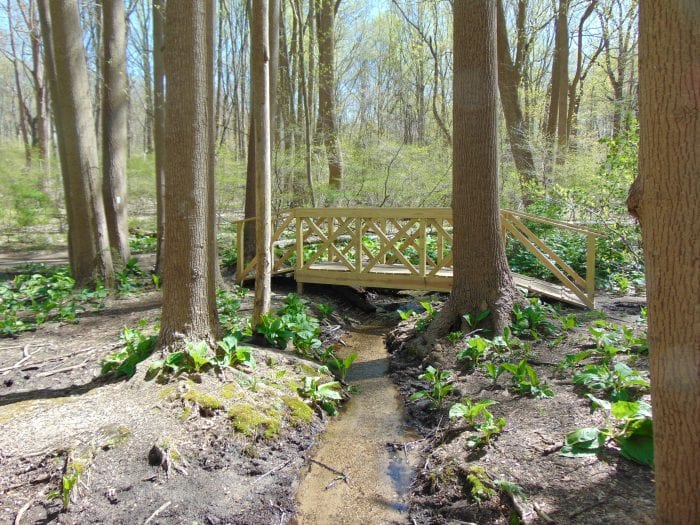
A resolution passed in the Suffolk County Legislature will place the onus on contractors when a structure encroaches onto county parkland.
The resolution, titled A Local Law to Ensure the Protection of County Parkland, passed in the Legislature June 23 and will take effect immediately after it is signed by County Executive Steve Bellone (D). The legislation requires a contractor working on private property that abuts parkland must obtain a copy of the land survey of the private parcel from the homeowner. The legislation also requires that the private property owner must submit a written affirmation that there have been no changes to the property since the survey. An affidavit must be filled out stating the work being performed is within private property and neither encroaches on or physically disturbs the adjacent parkland. It’s required that the affirmation be signed by the contractor and notarized.
“As Suffolk residents, we all bear the responsibility of being stewards of our environment.”
— Susan Berland
Fines for violation of the law are $50 for the first offense, $100 for the second and $250 for three or more.
The legislation was co-sponsored by county legislators Kara Hahn (D-Setauket), Susan Berland (D-Dix Hills), Samuel Gonzalez (D-Brentwood), Sarah Anker (D-Mount Sinai) and Jason Richberg (D-West Babylon) and was first introduced at the beginning of 2020. The legislation was inspired after a case in Smithtown where homeowners built a gazebo partly made of brick that was situated on a small piece of land that is part of Arthur H. Kunz County Park. The owners also had placed a putting green next to the structure.
“Suffolk County has long been a leader in protecting open space and parkland,” Berland said in an email. “As Suffolk residents, we all bear the responsibility of being stewards of our environment.”
Berland added that many residents encroached on public lands during her time as Town of Huntington councilwoman, where the town took some legal actions.
“These actions come at significant cost to taxpayers and can be avoided by ensuring that all involved in construction at these homes are certain that property boundaries are being observed,” the legislator said. “Suffolk County has a record of spearheading initiatives to safeguard the environment, earning us a regional and national reputation for innovation on this front. This resolution serves to further bolster that reputation.”
We don’t want people building and taking advantage of land that we’ve spent a lot of money to preserve for the residents of Suffolk County.
— Kara Hahn
Hahn said it makes sense for contractors to take extra precautions when building near parkland.
“If you’re a contractor, and you’re about to put down a fence, and the property next to you is 100 acres, you have to take a look and say, ‘Oh, what land is that,’” she said, adding it’s simple to determine what’s public parkland looking at online maps.
“It’s common sense,” the legislator said. “We don’t want people building and taking advantage of land that we’ve spent a lot of money to preserve for the residents of Suffolk County. We preserve it to prevent building on it.”
Hahn said the legislation will not only prevent intentional and unintentional encroachment but will also protect both the homeowners and contractors.
She said the protection of parkland is more important than ever as more residents search for outdoor activities during the pandemic.
“I think it’s abundantly clear how important [parklands] are to the health of our communities — our mental health, our physical health, community well-being — and it’s important to protect them in every way we can,” Hahn said.
ARS Landscape & Design adopts entrances to Huntington’s Heckscher Park
Supervisor Chad A. Lupinacci and Councilman Ed Smyth joined Andrew Steinmueller, President of ARS Landscape & Design, the first business to “adopt” and beautify two pieces of public property under the Adopt-a-Corner community beautification program, for a special unveiling of the installations at the southwest entrance to Heckscher Park in Huntington on June 24.
ARS Landscape & Design planted their first Adopt-a-Corner installation at the Prime Avenue entrance to the park in September of 2019 and added a second installation at the Main Street and Prime Avenue corner entrance to the park, maintaining both installations throughout the year.
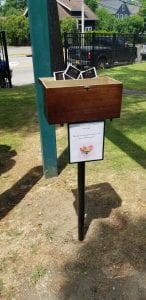 A box of complimentary wildflower seed packets was installed by the landscape company at the second installation, from which visitors to the park can take a complimentary seed packet. A second box of seed packets will be installed next to the first installation on the western Prime Avenue entrance to the park within the week.
A box of complimentary wildflower seed packets was installed by the landscape company at the second installation, from which visitors to the park can take a complimentary seed packet. A second box of seed packets will be installed next to the first installation on the western Prime Avenue entrance to the park within the week.
Businesses, organizations and residents can adopt, beautify and maintain a select piece of public property approved by the Town of Huntington for one year, with the option to renew for a second year.
Supervisor Lupinacci sponsored the Town Board resolution creating the Adopt-a-Corner program in October 2018 after Andre Sorrentino, the Town’s Director of General Services, approached him with the idea to involve the greater Huntington community in beautification projects across the town.
“Adopt-a-Corner is quality of life initiative, that offers a creative outlet for residents, business owners and organizations to display their pride in the Huntington community, while helping beautify our town at no cost to our taxpayers,” explained Supervisor Lupinacci. “Thank you to ARS Landscape & Design for these inaugural Adopt-a-Corner installations and for the seed packets they are giving away.”
 “I am the prime beneficiary of this Adopt-a-Corner installation because my office is located across the street,” stated Councilman Smyth. “I see this beautiful corner every day. I encourage everyone to make the town look its best by adopting a corner. The resident or business which adopts a corner may put place a small plaque with their name or dedicate the corner in honor of someone.”
“I am the prime beneficiary of this Adopt-a-Corner installation because my office is located across the street,” stated Councilman Smyth. “I see this beautiful corner every day. I encourage everyone to make the town look its best by adopting a corner. The resident or business which adopts a corner may put place a small plaque with their name or dedicate the corner in honor of someone.”
“Over these past few months, we have been faced with a pandemic that forced us all inside and gave us all a feeling of uncertainty. Audrey Hepburn once said ‘To plant a garden is to believe in tomorrow,’ I hope that by planting these gardens, I can spread a little joy and hope for what tomorrow may bring,” added Steinmueller.
Pictured in photo, from left, Councilman Smyth; Andre Sorrentino; Supervisor Lupinacci; Andrew Steinmueller (holding Addison Steinmueller); Bonnie Steinmueller (holding Ashton Steinmueller); Liz Steinmueller; and Joseph Digicomo. To apply to adopt a corner, visit www.huntingtonny.gov.
Photos courtesy of the Town of Huntington
Stony Brook University storm model predicts wetter, less frequent hurricanes
By Daniel Dunaief
At the beginning of this month, the North Atlantic started its annual hurricane season that will extend through the end of November.
Each year, the National Oceanic and Atmospheric Administration offers a forecast in May for the coming season. This year, NOAA’s Climate Prediction Center anticipates a 60 percent chance of an above-normal season. The Center anticipates 13 to 19 storms, although that number doesn’t indicate how many storms will make landfall.
These predictions have become the crystal ball through which forecasters and city planners prepare for a season that involves tracking disturbances that typically begin off the West coast of Africa and pick up energy and size as they travel west across the Atlantic towards Central America. While some storms travel back out to sea, others threaten landfall by moving up the Gulf Coast or along Atlantic Seaboard of the United States.
Kevin Reed, an Associate Professor at Stony Brook University’s School of Marine and Atmospheric Sciences, and Alyssa Stansfield, a graduate student in his lab, recently predicted the likely amount of rainfall from tropical cyclones.
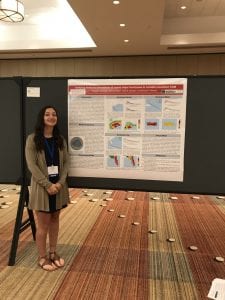
Using climate change projection simulations, Reed and Stansfield came up with a good-news, bad-news scenario for the years 2070 through 2100. The good news in research they published in Geophysical Research Letters is they anticipate fewer hurricanes.
The bad news? The storms will likely have higher amounts of rain, with increased rain per hour.
“If you focus on storms that make landfall over the Eastern United States, they are more impactful from a rainfall standpoint,” Reed said. “The amount of rainfall per hour and the rainfall impact per year is expected to increase significantly in the future.”
In total, the amount of rainfall will be less because of the lower number of storms, although the intensity and overall precipitation will be sufficient to cause damaging rains and flooding.
Warmer oceans and the air above them will drive the increased rainfall, as these storms pass over higher sea surface temperatures where they can gain energy. Warmer, moist air gives the hurricanes more moisture to work with and therefore more potential rainfall.
“As the air gets warmer, it can hold more water in it,” Stansfield said. “There’s more potential rain in the air for the hurricanes before they make landfall.”
Stansfield said the predictions are consistent with what climatologists would expect, reflecting how the models line up with the theory behind them. She explored how climate change affects the size of storms in this paper, but she wants to do more research looking at hurricane size in the future.
“If hurricanes are larger, they will drop rainfall over a larger area,” which could increase the range of area over which policy makers might need to prepare for potential damage from flooding and high winds, Stansfield said.
While her models suggest that storms will be larger, she cautioned that the field hasn’t reached a consensus about the size of future storms. As for areas where there is greater consensus, such as the increased rainfall their models predict for storms at the end of the century, Stansfield suggested that the confidence in the community about their forecasts, which use different climate models, is becoming “more apparent as more modeling groups reach the same conclusion.”
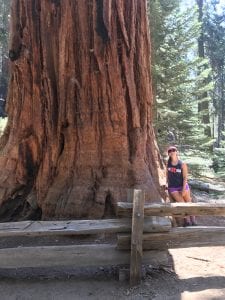
In explaining the expectations for higher rainfall in future storms, Reed said that even storms that had the same intensity as current hurricanes would have an increase in precipitation because of the availability of more moisture at the surface.
While storms in recent years, such as Hurricanes Harvey, Florence and Dorian dumped considerable rain in their path because they moved more slowly, effectively dumping rain over a longer period of time in any one area, it’s “unclear” whether future storms would move more slowly or stall over land.
Several factors might contribute to a decrease in the number of storms. For starters, an increase in wind sheer could disrupt the formation of some storms. Vertical wind sheer is caused when wind speed and direction changes with increasing altitude. Pre-hurricane conditions may also change due to internal variability and the randomness of the atmosphere, according to Reed.
Reed said the team chose to use climate models to make predictions for the end of the century because it is common in climate science for comparison to the recent historical record. They also used a 30 year period to limit some of the uncertainty due to internal variability of weather systems.
Stansfield, who is in her third year of graduate school and anticipates spending another two years at Stony Brook University before defending her graduate thesis, said she became interested in studying hurricanes in part because of the effects of Superstorm Sandy in 2012.
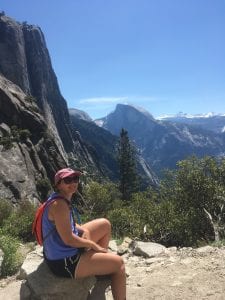
When she was younger, she and her father Greg used to go to the beach when a hurricane passed hundreds of miles off the coast, where she would see the impact of the storm in larger waves. At some point, she would like to fly in a hurricane hunter plane, traveling directly into a storm to track its speed and direction.
Stansfield said one of the more common misconceptions about hurricanes is that the category somehow determines their destructive power. Indeed, Superstorm Sandy was a Category 1 hurricane when it hit New York and yet it caused $65 billion in damage, making it the 4th costliest hurricane in the United States, according to the NOAA.
After Stansfield earns her PhD, she said she wants to continue studying hurricanes. One question that she’d like to address at some point is why there are between 80 to 90 hurricanes around the world each year. This has been the case for about 50 years, since satellite records began.
“That’s consistent every year,” she said. “We don’t know why that’s the number. There’s no theory behind it.” She suggested that was a “central question” that is unanswered in her field.
Understanding what controls the number of hurricanes will inform predictions about how that number will change in response to climate change.
THE JOY OF BIRDING: A photo essay by Jay Gao
FEATURED PHOTOGRAPHER: Jay Gao

Hometown: Stony Brook
Photographer: When empty-nested, I bought myself a Nikon D750 camera, my first DSLR, at the end of 2015 as a New Year’s gift. Before that, I had experience in using compact point and shoot cameras.
Favorite camera: Nikon D750, an entry-level full-frame DSLR. I love its strength in low-light performance.
Favorite lenses: For wildlife, I mostly use Sigma 150-600mm 5-6.3 Contemporary, and for travel I like to use Nikon 24-120mm f/4. When shooting flowers, I prefer to use Nikon AF-S VR Micro-NIKKOR 105mm f/2.8G.
Favorite locations: I love to visit the Stony Brook Mill Pond and Stony Brook Harbor with my camera. It is a beautiful place all year round and there are so many kinds of birds. As a matter of fact, this is mostly where I have been practicing my bird shots. My other favorite spots include my backyard, West Meadow Beach, Nissequogue River State Park and Sunken Meadow State Park.
Have you entered any photo contests? I won first place in the 2018 Better Newspaper Contest of New York Press Association; was selected to exhibit in the Oversea Chinese History Museum in Beijing by the committee of the 4th World Overseas Chinese Photography Exhibition (2019); and won in the “China’s City View” theme of Impression of China photography contest in 2020, although the display was canceled due to COVID-19 pandemic.
Favorite aspect about taking photos: I enjoy going out and shooting with my camera. In addition to appreciating and sharing of the beauty of mother nature, you can benefit from the fresh air and physical exercise.
Best advice to get that perfect shot:
Go out often and enjoy. When shooting birds, pay attention to the background and try to get close to their eye levels. I mostly use these camera settings: manual mode (1/1200 s, f8 and auto ISO), single point continuous focus and continuous shooting. I love to use the back button focus.
Photo of the Week
SUMMER TIDE
Elyse Buchman snapped this peaceful scene in her hometown of Stony Brook on June 14 while having a sunset dinner with her husband at the Hercules Pavilion.
Send your photo of the week to [email protected]
Gyrodyne Receives Guidance for Sewage Treatment Plant
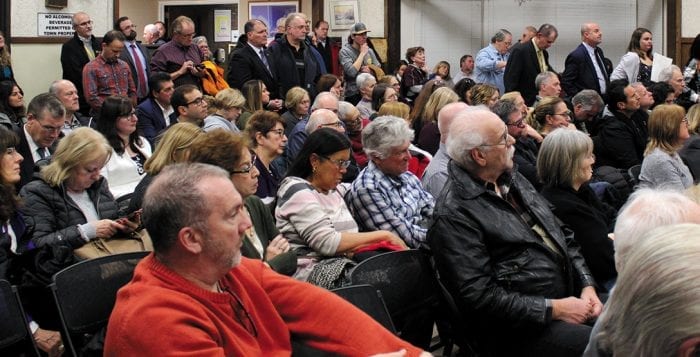
While plans are not set in stone, Gyrodyne in St. James now has some guidance regarding its proposed sewage treatment plant after a recent meeting of the Suffolk County Sewer Agency.
During a June 22 Zoom meeting, the agency members unanimously granted Gyrodyne what is known as conceptual certification for the plant, explaining that certification gives the applicant guidance regarding the type of wastewater disposal methods but is not an official approval.
Currently, the Town of Smithtown is conducting an environmental review of Gyrodyne’s proposal to subdivide the 75-acre-property to build a 150-room hotel with a restaurant, two assisted living centers, two medical office parks and a 7-acre sewage treatment plant.
If approved, the Gyrodyne Sewer Treatment Plant, which can handle 100,000 gallons per day of wastewater, could possibly be connected to new sewer lines in St. James.
Before the June 22 meeting, the county agency received letters opposing the approval of the treatment plant from state Assemblyman Steve Englebright (D-Setauket), county Legislator Kara Hahn (D-Setauket), Setauket Harbor Task Force co-founder and trustee George Hoffman, environmentalist Carl Safina, chair of the Greater Stony Brook Action Coalition/United Communities Against Gyrodyne, Cindy Smith, and others asking that any kind of approval not be granted.
Englebright wrote in his June 19 letter that even conceptualized certification would violate the intent and spirit of the State Environmental Quality Review Act. He also listed a sewage treatment plant would have a significant impact on Stony Brook Harbor, which is only a mile and a half from the proposed STP. The concern also was expressed by other writers.
Englebright said in his letter that the applicant only included the onsite wastewater needs when it came to the certification.
“Yet the applicant’s own SEQRA filing and numerous news reports indicate plans to tie in the St. James Business District, which is currently installing sewer pipes on Lake Avenue which would nearly double the amount of wastewater discharged to groundwater to 170,000 [gallons per day],” Englebright wrote.
During the Zoom meeting, Hoffman said if someone was looking for the worst spot to put a STP, the Gyrodyne property would be it. Smith said that the entire area should be studied, including watersheds all along Route 25A.
Safina was also on hand for the Zoom meeting.
“The Gyrodyne plan appears to be an attempt to simply pull a fast one on all the residents in and around the Stony Brook Harbor watershed,” he said.
Suffolk County Legislator Rob Trotta (R-Fort Salonga) added his comments during the Zoom meeting. While he said, “I wish this property was preserved forever,” he added that the owner could do whatever it wanted with it.
“I’d rather have open space but I’m a realist,” he said.
Mark Wagner from Cameron Engineering attended the meeting to represent Gyrodyne. He said the treatment plant would actually decrease the nitrogen leaving the site and going into the watershed.
Hauppauge-based attorney Tim Shea addressed concerns voiced about Gyrodyne selling off land parcels in the future. He said while the company anticipated selling off such parcels, buyers would have to enter a property owners association. Members of the association would be required to maintain the STP.
Before Gyrodyne can move forward with constructing the STP, the Town of Smithtown must complete the SEQRA review and the county sewage agency must grant final approval.
U.S. Reps Promote Bipartisan Bill to Stop Taxation on Experimental Septics
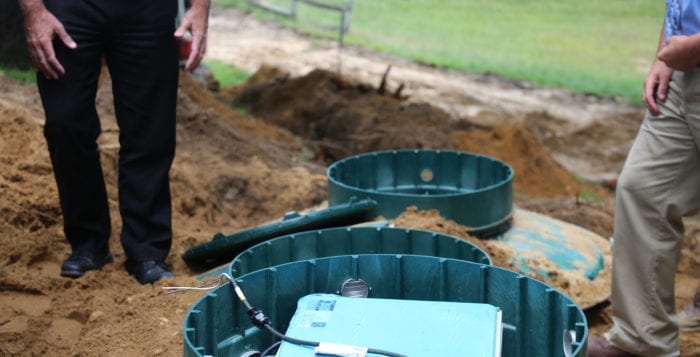
Republican and Democratic congressmen from Long Island are promoting a bill that would cancel the taxable status placed on grants for prototype denitrifying septic systems in Suffolk County and offer relief to those who received those grants.
Both U.S. Rep. Lee Zeldin (R-NY1) and Tom Suozzi (D-NY3) are promoting legislation that would essentially reverse the U.S. Internal Revenue Service’s ruling that grants for the experimental septic systems were taxable, despite Suffolk County and other local officials saying there was precedent for such grants on home-based environmental devices being tax free.
“Cesspools and septic systems have been identified as the largest single cause of degraded water quality on Long Island,” Suozzi said in a statement. “This bill may not sound exciting, but it has a real impact on real people’s lives and pocketbooks.”
The IRS ruling came down in January of this year after Suffolk County Comptroller John Kennedy Jr. (R) asked the IRS for such a decision. The comptroller sent tax bills to homeowners who had taken up such grants in 2019, saying the county should have constructed the program to make sure that the feds would tax the contractors, not those who received the grants. County Executive Steve Bellone (D) said in a statement that “the notion that Suffolk County homeowners would be taxed for participating in a water quality program that will make their water cleaner simply defies all logic.”
Zeldin said they have to protect taxpayers.
“This program’s goals are laudable, but we must ensure people can actually use the program to achieve those goals. While all levels of government work to find a solution, due to the urgency of this situation, we are running the gamut on every option, including this legislation to provide immediate relief,” he said in a release.
The bill would also retroactively allow people who received the grants to amend their 2019 tax returns for grants received in the same year.
The legislation is expected to be included within a larger congressional infrastructure package that will be voted on within the next few weeks.


